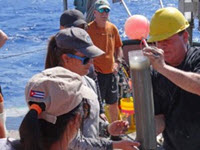Gulf-wide baseline for oil pollution monitoring complete!

Marine geologist David Hollander (USF, right) instructs Cuban students on sediment core sampling techniques off northwest Cuba. Dr. Greg Brooks (Eckerd College, orange shirt) assists. Photo courtesy of C-IMAGE (Click image for more info and details)
Marine scientists advanced academic relations between the U.S. and Cuba during an 18-day research expedition (May 8-25) off the northwest coast of the island nation. Twenty-four scientists representing four universities sailed on the R/V Weatherbird II and collected 450 fish, 50 plankton, 150 water, and 1,500 sediment samples. They also tagged and released sharks.
The team will add the suite of samples from Cuban waters to collections gathered over the past four years from across the Gulf of Mexico. Now, with a comprehensive catalogue of environmental baseline specimens complete, scientists will be able to determine the presence of petroleum chemical signatures and better understand ecological impacts of future oil spills.
The U.S. team includes members of the Center for Integrated Modeling and Analysis of Gulf Ecosystems (C-IMAGE) consortium led by Steven Murawski of the University of South Florida (USF) who served as the expedition’s co-chief scientist. Researchers represented USF, Eckerd College, Texas A&M University – Corpus Christi, and Florida State University. The Cuban team was led by Maickel Armenteros, the expedition’s other co-chief scientist, with the University of Havana’s Centro de Investigaciones Marinas and included researchers from Centro de Estudios Ambientales de Cienfuegos.
Click here for more details and images regarding this historic One Gulf Expedition….
************
This research was made possible in part by a grant from the Gulf of Mexico Research Initiative (GoMRI) to the Center for the Integrated Modeling and Analysis of Gulf Ecosystems II (C-IMAGE II).
The Gulf of Mexico Research Initiative (GoMRI) is a 10-year independent research program established to study the effect, and the potential associated impact, of hydrocarbon releases on the environment and public health, as well as to develop improved spill mitigation, oil detection, characterization and remediation technologies. An independent and academic 20-member Research Board makes the funding and research direction decisions to ensure the intellectual quality, effectiveness and academic independence of the GoMRI research. All research data, findings and publications will be made publicly available. The program was established through a $500 million financial commitment from BP. For more information, visit http://gulfresearchinitiative.org/.
© Copyright 2010- 2017 Gulf of Mexico Research Initiative (GoMRI) – All Rights Reserved. Redistribution is encouraged with acknowledgement to the Gulf of Mexico Research Initiative (GoMRI). Please credit images and/or videos as done in each article. Questions? Contact web-content editor Nilde “Maggie” Dannreuther, Northern Gulf Institute, Mississippi State University (maggied@ngi.msstate.edu).
